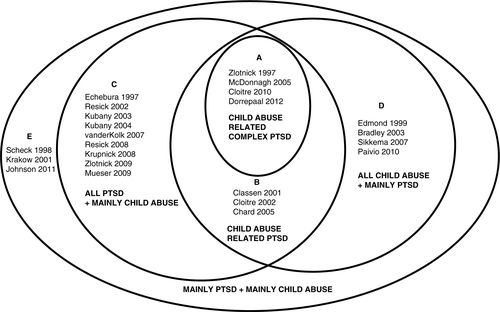Figures & data
Fig. 1 RCTs on child abuse (CA) and or PTSD.
Category A: CA-related Complex PTSD (4 RCTs): All study participants diagnosed with Complex PTSD or >50% with personality disorder; PTSD as target symptoms. All CA. All CA as index trauma.
Category B: CA-related PTSD (3 RCTs): All study participants diagnosed with PTSD as target symptoms. Outcome measures also covering some Complex PTSD symptoms All CA. All CA as index trauma.
Category C: All PTSD + mainly CA (9 RCTs): All study participants diagnosed with PTSD as target symptoms. >50% CA or <50% but CA population analyzed separately. Index trauma sometimes CA, mainly rape or domestic violence.
Category D: All CA + mainly PTSD (5 RCTs): Study participants >50% PTSD or substantial PTSD symptomatology (PTSD patients not analyzed separately); PTSD as target symptoms. All CA. All CA as index trauma.
Category E: Mainly PTSD + mainly CA (3 RCTs): Study participants >50% PTSD (as target symptoms) and >50% CA.

Table 1 Study characteristics of randomized controlled trials with CA-related (Complex) PTSD (A+B): N, population, recruitment, inclusion and exclusion criteria, assessment and severity of trauma and symptoms and previous treatments
Table 2 Treatment characteristics of randomized controlled trials with CA-related (Complex) PTSD (A+B)
Table 3 Drop-out rates, pretreatment and posttreatment scores (mean, SD), and effect sizes of pretreatment versus posttreatment and treatment versus waiting list or other treatment, recovery and improvement rates on PTSD symptom severity (completers and intention-to-treat) per included study
Table 4 Aggregated drop-out, prescores and postscores, and effect sizes for PTSD symptom changes, and recovery and improvement rate across CA-related PTSD studies by type of treatment
Table 5 Aggregated drop-out, prescores and postscores, and effect sizes for PTSD symptom changes, and recovery and improvement rate across CA-related Complex PTSD studies by type of study population
